GP35
| SITE: GP35 . | Aust. Soil Class.: Acidic-Sodic, magnesic, Brown DERMOSOL |
| Great Soil Group: podzolic | General Landscape Description: Gentle undulating plain. E. teretecornis.??? |
| Site Description: Paddock reserve | |
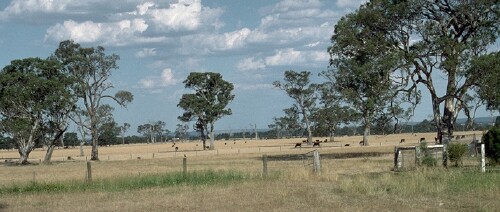
GP35 Landscape
Soil Profile Morphology:
Surface Soil
| A1 | 0-15 cm | Very dark greyish brown (10YR3/2); loam, fine sandy; weak medium polyhedral structure; pH 5.6; clear change to: | 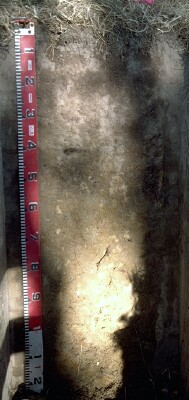 GP35 Profile |
| A2 | 15-50 cm | Brown (10YR5/3) sporadically bleached (10YR8/1d) with a brownish yellow (10YR6/8) mottle; fine sandy clay loam becoming sandy clay loam; apedal structure; very strong consistence moist; pH 5.0; clear change to: | |
| Subsoil | |||
| B21 | 50-70 cm | Brown (10YR5/3) with brownish yellow (10YR6/8) mottles; some dark staining; light medium clay; weak structure; very strong to rigid consistence moist; contains a few (5-10 %) quartz fragments (2-5 mm in size); pH 5.4: | |
| B22 | 70-120 cm | Light brownish yellow (10YR6/4) with very pale brown (10YR7/3) and brownish yellow (10YR6/8) mottles; light medium clay; weak coarse blocky, breaking down to moderate polyhedral structure; contains a few (5-10%) quartz nodules (2-5 mm in size); pH 5.6: | |
| B23 | 120+ cm | Pale brown (10YR6/3); sand. | |
Key Profile Features:
- Lack of strong texture contrast between surface (A) horizon (15% clay) and strongly sodic subsoil (B21) horizon (26% clay).
pH | Salinity Rating | |||
Surface (A1 horizon) | moderately acid | very low | non-sodic | none (mod r/m) |
Subsoil (B21 horizon) | strongly acid | very low | strongly sodic | strong |
Deeper subsoil (at 1 m) | moderately acid | very low | strongly sodic | complete |
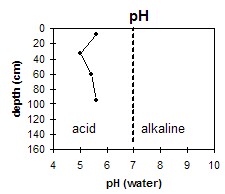 The surface is moderately acid. The subsoil is strongly acid and becomes moderately acid at 80 cm. | 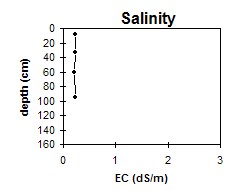 The salinity rating is low throughout the profile. | 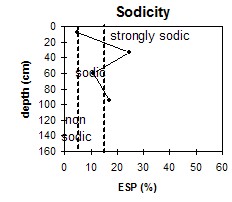 The surface is non-sodic. The subsoil is mainly strongly sodic. |  The clay content increases slightly at 50 cm depth. |
Surface (A) Horizon
- The surface (A1) horizon has a high fine sand content (31%). Soils such as these rely to a large extent on organic matter for maintaining aggregation. The levels of organic carbon measured at the pit site (which may or may not be representative of the whole paddock) is high. Organic matter levels will build up under pasture but will decline if cropping takes place. Practices such as residue retention, minimum tillage and including pasture rotations could be utilised if cropping takes place in order to build up organic matter, improve aggregation as well as assist in the low water holding capacity and reduce erosion risk.
- The inherent fertility is moderate which is beneficial to plant growth.
- The surface (A1) horizon is non-sodic with no dispersion. The presence of moderate dispersion after remoulding indicates that structural degradation (e.g. surface sealing, increased cloddiness) may occur if the soil is cultivated or overstocked in a moist to wet condition. Also, raindrop action on bare surface soil may also promote dispersion. Surface cover should be maintained to protect against raindrop damage.
- The presence of sporadic bleaching in the subsurface (A2) horizon indicates that periodic waterlogging occurs above the slowly permeable subsoil.
- The upper subsoil is strongly sodic and has a low exchangeable calcium to magesium ratio (i.e. 0.1). Strong dispersion occurs as a result restricting root and water movement. Gypsum could be added to the surface but it would require some time to wash the gypsum down to the subsoil and less of it would probably make it.
- The upper subsoil is strongly acid and some deep rooted vegetables will not grow well in these highly acid conditions. Acid soils can also have high aluminium and manganese levels which are toxic to plants. Laboratory tests show that the aluminium level of 100 ppm is enough to effect sensitive plant species such as canola and some wheat varieties. It would not be economic to add lime to raise the pH due to the extent and depth of the aluminium toxicity.
- The subsoil is mottled throughout and there are stains on ped faces which indicates that there is some waterlogging within these clayey horizons.
- The upper subsoil has a ridig consistence and has a low inherent fertility. This is not conducive to root development.


